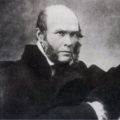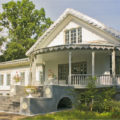On the 210th anniversary of the great surgeon Nikolay Pirogov
The name of the outstanding surgeon, thinker, and teacher Nikolay Pirogov is widely known throughout Russia and abroad. His remarkable life has served as an example of dedication, devotion and commitment to science. The years go by and decades pass, but Pirogov’s contribution to medicine has remained unequalled.
The future great surgeon was born in Moscow on November 27, 1810. He was the 13th child in the close-knit and well-to-do family of the military treasurer, Major Ivan Pirogov. Ever since Nikolay was little, his favorite pastime was to imagine that he was a doctor. He was inspired by Efrem Muhin, a famous medical professional and Professor at Moscow University, who once examined Pirogov’s older brother when he was sick. The visit of the celebrity and the amazing recovery of the patient left a lasting impression on Nikolay. From that moment on, the boy started to “treat” his folks pretending he was a doctor. Lying in the bed, the patients let the young doctor perform auscultation as well as palpation and watched him write prescriptions and give recommendations with an air of importance.
It was professor Muhin who helped Nikolay get his education: he quickly noticed the boy’s brilliant abilities and started to tutor him individually. At the age of 14, Nikolay stated that he was 16 in his university application and successfully passed the entrance exams to the Medical Faculty of the Moscow University. However, this place was a rather pitiful sight in the 20s of the 19th century. With minor exceptions, the professors were talentless and very formal about their work. As a rule, the academic process consisted of lectures based on outdated information, although there were some more up-to-date books. However, Nikolay had an enquiring mind and did his best to learn, first of all, from the elders. Apart from Efrem Muhin, the Anatomy Professor Justus Loder had a tremendous impact on young Pirogov as well. His subject fascinated Nikolay so much that he began to study it with enthusiasm, but only the theoretical part, as there were no practical exercises with corpses at that time.
Besides, Pirogov was greatly influenced by his university friends, with whom he used to spend a lot of time. Many of them were progressively minded. Gathering in the dormitory room number ten, they had heated debates about politics, read forbidden poetry, and reveled impetuously. These people had a profound impact on Nikolay’s personality: they helped the medical student broaden his horizons, which had considerably shaped his intellectual capacity and moral guidelines.
After the death of his father, Pirogov’s family was gradually reduced to poverty. Nikolay’s mother and sisters found jobs, and he continued his studies; thankfully, the fees were low, and no dress jackets had been introduced yet. They appeared a little later, and Pirogov’s sisters sewed a jacket with a red collar from a worn-out tailcoat for him. To avoid being accused of dress code violation, he did not take off his overcoat at the lectures, showing a red collar. Thus, Nikolay managed to graduate thanks to the support of his family.
After that, Pirogov was enrolled in the Imperial University of Dorpat in Tartu, where he defended his thesis and became a professor of surgery at the age of 23. Five years later, Nikolay decided to continue his education in Berlin, and an important event occurred in his professional life on his way there. He fell ill and had to stay in Riga for a long time. As soon as he recovered, he began to work. One of his first patients was a barber who had lost his nose as a result of a tragic accident. Pirogov performed a sophisticated surgery and made his patient look the way he used to before. This was the beginning of rhinoplasty.
The first plastic surgery was followed by numerous amputations and tumor removal. Pirogov never stopped improving his technique, describing his surgeries and creating drawings, which were absolutely different from the anatomical atlases and tables that existed at that time.
Having returned to Russia, in 1841, Pirogov headed the Department of Surgery at St. Petersburg Imperial Medical and Surgical Academy. He had worked there for ten years and founded the first clinic of hospital surgery in the country. At the same time, Nikolay was appointed the director of the Instrumental Plant. It gave him an opportunity to implement his innovative ideas to make the surgical instruments more functional. Pirogov’s novelties made it possible for doctors to get advanced tools with which they could work faster and more efficiently. The compilation of a detailed anatomical atlas was one of the priority tasks for Pirogov, to which he devoted a lot of time.
Constantly practicing and saving dozens of lives, the doctor couldn’t stop wondering how to avoid amputation, relieve physical pain, and speed up the postoperative recovery. Nikolay looked for answers to these questions in the morgue, meticulously studying frozen corpses. This gave him an accurate picture of the location of internal organs and nerves and laid the foundation for a new medical discipline, topographic anatomy.
The Pirogov’s atlas earned him world recognition. It contained not only information on topographic anatomy, but also the results of the experiments conducted by the scientist on the corpses. Later, this invaluable work allowed the doctors to perform surgeries with minimal damage and became the basis for the development of surgery in general.
Nikolay Pirogov devoted a lot of time to the research on the anesthetic effects of chloroform and ether that were discovered in 1847. First, he tested them on animals and soon introduced ether anesthesia into clinical practice. Such anesthesia also proved indispensable on the battlefields.
Having gone to the Caucasus to join the acting army, Pirogov successfully practiced field surgery using his new developments. Thus, he worked right between the camp tents, so that the wounded soldiers could see the ether’s painkilling effect and lie under the surgeon’s knife without fear.
There were several more wars in Pirogov’s life, by saving people in which not only did he master his skills, he contributed to the development of medicine in general. It was him who first used plaster casts and applied various types of wound treatment in the field. Thanks to the scientist, nurses appeared in military hospitals.
The work on the basics of general military and field surgery, in which Pirogov summed up the results of his long fight against wound infections, is of the utmost importance, as it was wound infections, not surgeries, that caused the deaths of most soldiers. The scientist realized that infections and rotten poisonous fumes can be of different origins. That is why it was necessary to isolate some of the wounded from the others with the emergence of purulent infections and gas gangrene, so as to provide rational and timely assistance.
Pirogov’s research on Asiatic cholera is also invaluable. The epidemic of the disease, which was little-known at the time, broke out in Russia in 1849 and claimed hundreds of thousands of lives. To study this contagious infection, Pirogov established a special department at his clinic. During the epidemic, he performed about 800 autopsies of those who died of cholera. He presented the results of his research in a voluminous work with illustrations in color. For this, Pirogov was awarded the Demidov Prize, an honorary non-governmental award for outstanding contribution to the development of science.
Nikolay Pirogov was married twice and had two sons who became scientists. However, for him, the most important things in life were his medical, scientific, and pedagogical activities. The latter concerned, in particular, the issues of the upbringing of children and the organization of the public education system.
In early 1881, the prominent Russian doctor Nikolay Sklifosovsky diagnosed Pirogov with upper jaw cancer, from which Nikolay died in the summer of the same year. His body was embalmed using the technique he developed himself and buried in the tomb on the territory of the scientist’s estate. After his death, the Pirogov Society was founded. It became a highly reputable voluntary association of doctors in the Russian Empire, and it still exists today. Annually, the awards named after Pirogov are presented for the achievements in anatomy and surgery on the date of his birthday. The Russian National Research Medical University and the Vinnytsia National Medical University were named in honor of this great doctor.
Irina Sheikhetova



